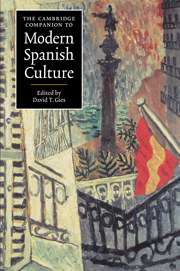Book contents
- Frontmatter
- Modern Spanish culture
- I Culture
- II Culture and history
- III Culture and prose
- IV Culture and poetry
- V Culture and theater
- VI Culture and the arts
- 17 Painting and sculpture in modern Spain
- 18 Culture and cinema to 1975
- 19 Culture and cinema, 1975-1996
- 20 A century of Spanish architecture
- 21 Spanish music and cultural identity
- 22 To live is to dance
- VII Media
- Index
- Series List
20 - A century of Spanish architecture
from VI - Culture and the arts
Published online by Cambridge University Press: 28 May 2006
- Frontmatter
- Modern Spanish culture
- I Culture
- II Culture and history
- III Culture and prose
- IV Culture and poetry
- V Culture and theater
- VI Culture and the arts
- 17 Painting and sculpture in modern Spain
- 18 Culture and cinema to 1975
- 19 Culture and cinema, 1975-1996
- 20 A century of Spanish architecture
- 21 Spanish music and cultural identity
- 22 To live is to dance
- VII Media
- Index
- Series List
Summary
Upon Antoni Gaudís birth in 1852, less than ten years had passed since the foundation in Madrid of the first national School of Architecture, an institution born of the old Academy of Fine Arts. The vigorous urban development characteristic of Spain during the Restoration gave rise to a new generation of well-prepared builders. The young Gaudí, who had studied at the Facultad de Ciencias of the University of Barcelona, was now able to complete his education at the School of Architecture in Barcelona, established only a few years prior to his graduation. This wave of architecture graduates, educated in Madrid or Barcelona, would practice their profession within the framework of the new urban plans encouraged by the legislation of 1864,1876, and 1892 which regulated the expansion of major cities. Barcelona, with its 1859 Plan Cerdá, and Madrid, with its i860 Plan Castro, set the pace for the rest of the nation in urban design. This was further emphasized in the former case by the strategic talent of Ildefonso Cerda, who put in place the cornerstone of modern urbanism with his Teoría General de la Urbanizacion (A General Theory of Urbanization). The bourgeoisie, a prosperous class which was made wealthy by mining, railroads, Basque metallurgy, and Catalan textiles, embraced urban development and real estate with a fervor that was further nourished by foreign investments and a dynamic stock market.
- Type
- Chapter
- Information
- The Cambridge Companion to Modern Spanish Culture , pp. 278 - 286Publisher: Cambridge University PressPrint publication year: 1999



